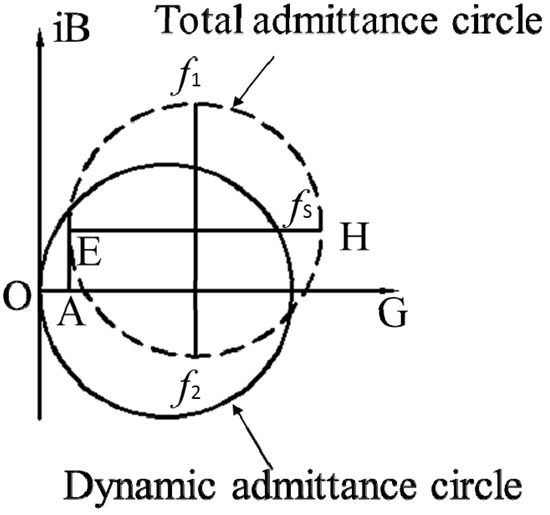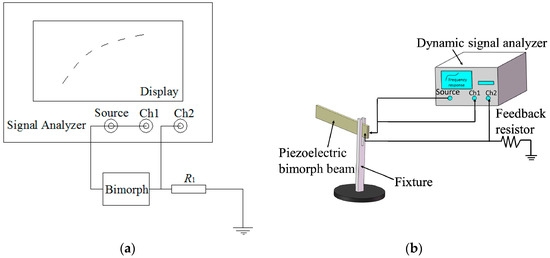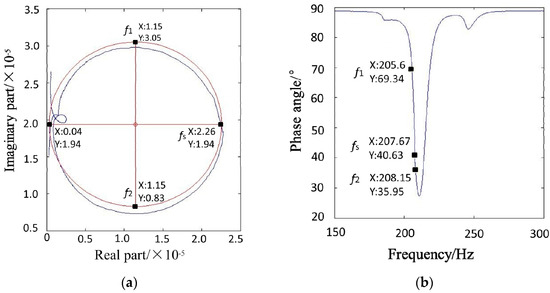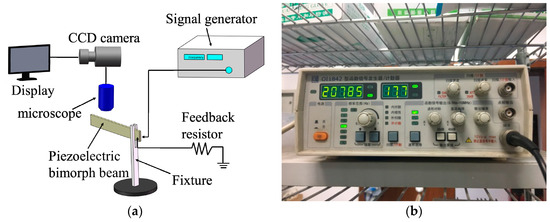Abstract
A piezoelectric bimorph beam, as an upgraded cantilever beam structure, can be used to detect gas content and build a micro-actuator, among other functions. Thus, this beam is widely applied to microelectromechanical systems (MEMS), transformers, and precision machinery. For example, when photoacoustic spectroscopy is performed to detect oil-soluble gas in transformers, a micro-cantilever beam can be used to detect gas content. The dynamic characteristics of piezoelectric bimorph beams, such as resonant frequency, are important indexes in the applications of these beams. The equivalent circuit model for a piezoelectric bimorph beam is examined in this study and an admittance test is performed on the beam to accurately, quickly, and economically measure and analyze its dynamic characteristics. Then, the least squares method is applied to obtain the characteristic curves of the admittance circle, amplitude frequency, and phase frequency; identify the dynamic characteristics of the piezoelectric bimorph beam (e.g., resonant frequency); and determine the parameters of the equivalent circuit. The resonant frequency of the piezoelectric bimorph beam is 207.67 Hz based on the result of the admittance circle test, which is basically consistent with the results of microscope image method (i.e., 207.85 Hz) and the theoretical calculation (i.e., 222.03 Hz). This finding proves the validity of the proposed test method. This method cannot only improve the detection speed of piezoelectric bimorph beams, but can also provide a fast detection strategy for testing the characteristics of such beams during photoacoustic spectroscopy.
1. Introduction
A micro-piezoelectric bimorph beam is made of piezoelectric, elastic, and metallic materials, with the metallic materials acting as a common electrode [1,2,3]. This type of beam can effectively amplify the static displacement and amplitude of piezoelectric materials, and thus, it is widely used in transformers, microelectromechanical systems (MEMS), and precision machinery, among other functions [4,5]. For example, the detection of an oil-soluble gas in transformers is a critical monitoring procedure that can effectively reflect overheating and partial discharge in transformers. The detection process is described as follows. An oil and gas separation system is used to extract trace gas dissolved in transformer insulation oil. Partial overheating and discharge level within the transformer is then determined based on gas content. Subsequently, the components of the gas mixture are identified and separated via photoacoustic spectroscopy to conduct a comprehensive assessment of transformer performance. A micro-piezoelectric bimorph beam can be used as the sound signal detection device in photoacoustic spectrum detection [6,7,8].
The dynamic characteristics of piezoelectric bimorph beams, such as resonant frequency, are important indexes in the applications of such beams [9,10,11]. At present, laser Doppler, stroboscopic micro-vision, and stroboscopic micro-interference can achieve dynamic characteristics for a high-precision, non-contact measurement of microstructures [12,13]. However, these test methods exhibit low efficiency and require complex equipment. Therefore, an admittance test method is proposed in this study to realize low-cost, accurate, and fast measurement and analysis of the dynamic characteristics of piezoelectric bimorph beams. This method is based on the electromechanical coupling characteristics of these beams. The mechanical vibration characteristics of a piezoelectric bimorph beam can be determined by measuring and analyzing its electrical admittance characteristics [14,15].
2. Analysis of the Equivalent Circuit and Principle of a Piezoelectric Bimorph Beam
The structure of the commonly used piezoelectric bimorph beam is shown in Figure 1a. This beam is composed of two piezoelectric patches with the same polarization directions and a common electrode in the middle. The two piezoelectric patches are wired, and alternating current (AC) voltage is applied (Figure 1a). The driving electric fields applied to the plates are always opposite each other. The polarization directions of the two piezoelectric patches are the same; hence, one of the plates contracts, whereas the other expands. This condition causes the piezoelectric bimorph beam to bend and swing. The swing frequency corresponds to the applied alternating current frequency.

Figure 1.
Piezoelectric bimorph beam (a) the structure; (b) equivalent circuit.
A piezoelectric bimorph beam is an electromechanical coupling device. Its equivalent circuit is shown in Figure 1b [16], where C0 is the static capacitance, R0 is the dielectric loss parallel resistance, Rd is the dynamic resistance, Cd is the parallel capacitance, and Ld is the dynamic inductance. When the mechanical quality factor of a component is high, Cd and Ld can be considered constant within the range of a given resonance frequency. The value of Rd is related to the mechanical energy of mechanical loss. The impedance of the circuit is simplified as its static admittance as
Dynamic admittance:
Total admittance:
The solid and dotted lines of the dynamic admittance on the complex plane form a circle, which is called an admittance circle.
Similarly, the total admittance on the complex plane also forms an admittance circle.
The dynamic admittance circle and the total admittance circle are represented by solid and dotted lines, respectively, in Figure 2.

Figure 2.
Dynamic admittance circle and total admittance circle.
The diagram of the admittance circle is used to identify all the parameters of the equivalent circuit of the piezoelectric bimorph beam. The diameter of the circle is set as D, then
A straight line (EH) is drawn parallel to the conductive axis that passes through the center of the circle. Then, the circle is intersected at point H. The frequency that corresponds to point H is the mechanical resonance frequency fs. Static capacitance and dielectric loss resistance can then be determined.
Using the corresponding distance from Figure 2, the static capacitance can be determined
Using the corresponding distance from Figure 2, the dielectric loss resistance can be determined
A straight line is drawn perpendicular to the conductive axis. The intersection frequencies are f1 and f2 [17,18,19]. Then, using the corresponding distances and frequencies from Figure 2, the dynamic inductance and parallel capacitance can be determined.
Dynamic inductance:
Parallel capacitance:
3. Methods for the Admittance Test of a Piezoelectric Bimorph Beam
This study uses a dynamic signal analyzer to test the admittance spectrum of a piezoelectric bimorph beam based on the preceding theoretical analysis. The detection principle is illustrated in Figure 3a. In the figure, the piezoelectric bimorph beam and feedback resistance R1 (resistance value = 1 Ω; hence, the values of the passing voltage and current are equal) are in series connection: one end is connected to the ground, whereas the other end is connected to the signal source of the dynamic signal analyzer. The voltage value U1 of the signal source and the voltage value U2 of the feedback resistor are input into Channel 1 (Ch1) and Channel 2 (Ch2) of the analyzer, respectively. The function of the feedback resistor is to convert the current signal of the piezoelectric bimorph beam into a voltage signal for the input analyzer. The calculation function of the dynamic signal analyzer can be used to obtain the admittance Yc(ω) (reverse of resistance) of the piezoelectric bimorph beam as
where and are the current and voltage of the piezoelectric bimorph beam, respectively; and and are the feedback resistor and voltage of the signal source, respectively.

Figure 3.
The admittance test of a piezoelectric bimorph beam. (a) The detection principle; (b) Schematic diagram of the admittance test system.
As shown in Figure 3b, the admittance test system for the piezoelectric bimorph beam comprises the piezoelectric bimorph beam, a fixture, a feedback resistor, and a dynamic signal analyzer (SR785, Stanford Research Systems, Inc., Sunnyvale, CA, USA). The piezoelectric bimorph beam is 50 mm long, 2 mm wide, and 0.7 mm thick. The fixture is used to clamp one end of the piezoelectric bimorph beam, and the cantilever beam is left with a length of 35 mm. The dynamic signal analyzer is used to apply excitation signals with different frequencies to the piezoelectric bimorph beam to measure the admittance value of the beam and obtain the admittance circle. Consequently, the resonant characteristics of the piezoelectric bimorph beam can be analyzed.
4. Experiment Result and Discussion of the Admittance Test
The admittance test system for the piezoelectric bimorph beam is used to measure the admittance circle curve (blue line in Figure 4a) and the phase frequency characteristic curve (Figure 4b). As shown in Figure 4a, the measured admittance curve is not perfectly round due to various interference factors, such as interference curves. To determine the relevant parameters, this study uses the circular fitting method to make the fitted circle (red line in Figure 4a) an approximation of the measured admittance circle through MATLAB software (R2010a, MathWorks, Inc., Natick, MA, USA). The specific method is described as follows [20].

Figure 4.
(a) Admittance circle curve; (b) Phase frequency characteristic curve.
The center of the admittance circle is set as (−a/2, −b/2), the radius is r, and the equation of the circle is
That is,
Through the least squares method,
where (xi, yi) are the coordinates at a certain point on the measured admittance circle.
The center of the fitted admittance circle is (1.15 × 10−5, 1.94 × 10−5) and the radius is 1.11 × 10−5 m, which can determine the coordinates of the frequency points of the piezoelectric bimorph beam on the admittance circle curve (Figure 4a), the resonant frequency point fs (2.26 × 10−5, 1.94 × 10−5), and the two auxiliary frequency points, i.e., f1 (1.15 × 10−5, 3.05 × 10−5) and f2 (1.15 × 10−5, 8.3 × 10−6). The coordinates of each frequency point are used to obtain their phase angle θ according to the formula θ = arctan(Y/X). The frequency region of the phase angle in the phase frequency characteristic curve is observed. Then, MATLAB software is used to search for the coordinates of each frequency point in the phase frequency characteristic curve (Figure 4b), the resonant frequency point fs (207.67, 40.63), the auxiliary frequency point f1 (205.60, 69.34), and the auxiliary frequency point f2 (208.15, 35.95) is obtained. Therefore, the resonant frequency point fs = 207.67 Hz and the auxiliary frequency points f1 = 205.60 Hz, f2 = 208.15 Hz are determined.
Subsequently, all the parameters in the equivalent circuit of the piezoelectric bimorph beam are obtained as
To verify the feasibility and accuracy of the admittance test result, the microscope image observation method is used to retest the resonant frequency of the piezoelectric bimorph beam. A system diagram of the microscope image observation method is shown in Figure 5a. The system includes the piezoelectric bimorph beam, a fixture, a signal generator (OI1842, Beijing Ocean Xingye Technology Co., Ltd., Beijing, China), and a probe system (M150, Cascade Microtech, Inc., Beaverton, OR, USA); and the probe system contains a microscope, a charge-coupled device (CCD) camera, and a display. The principle of the test is described as follows. When the signal generator provides electrical signals to the piezoelectric bimorph beam, the beam begins to vibrate. The vibration of the beam is observed through the microscope and the CCD camera. The piezoelectric bimorph beam is in a resonant state when the frequency of the electrical signals supplied to it is equal to its resonant frequency. The amplitude of the piezoelectric bimorph beam observed on the display is highest during that time, and the excitation signal frequency displayed on the signal generator is the resonant frequency of the beam.

Figure 5.
(a) Schematic diagram of the microscope image observation method and (b) the value of the signal generator when the piezoelectric bimorph beam is in a resonant state.
To ensure the accuracy of the test experiment, we use the same clamping method applied to the admittance test—i.e., the fixture is used to clamp one end of the piezoelectric bimorph beam—while leaving the cantilever beam with a length of 35 mm. Thereafter, the signal generator is used to apply excitation signals with different frequencies to the piezoelectric bimorph beam. The vibration of the piezoelectric bimorph beam is observed on the display.
The value of the signal generator is shown in Figure 5b when the amplitude of the piezoelectric bimorph beam is at its highest during the experiment. The piezoelectric bimorph beam is in a resonant state when the electrical signal is 207.85 Hz. Therefore, the resonant frequency is 207.85 Hz, which is basically consistent with the resonant frequency of 207.67 Hz obtained through the admittance circle. This result proves the feasibility and accuracy of applying the admittance circle to analyze the dynamic characteristics of a piezoelectric bimorph beam.
Moreover, the resonant frequencies of the piezoelectric bimorph beam can be theoretically calculated. We have calculated the resonant frequency of the piezoelectric bimorph beam as 222.03 Hz, when compared to the resonant frequencies obtained from the experiments, the differences are less than 8%, and the differences may be caused by the measurement errors, including measure of the cantilever beam size, the clamping position of the cantilever beam, and so on. Therefore, the theoretically calculated result can also prove the feasibility and accuracy of applying the admittance circle to analyze the dynamic characteristics of a piezoelectric bimorph beam.
5. Results
In summary, this study presents the application of an admittance test to determine the dynamic characteristics of a piezoelectric bimorph beam. A dynamic signal analyzer is used to perform the admittance test on the beam. The admittance circle and phase frequency curves of the piezoelectric bimorph beam are fitted by using MATLAB software. Then, the dynamic characteristics of the piezoelectric bimorph beam, such as resonant frequency, are obtained by analyzing the admittance circle and phase frequency curves, and then the equivalent circuit parameters are identified. Finally, the microscopic image observation method and theoretical calculation are conducted to redetermine the resonant frequency of the piezoelectric bimorph beam. The results are basically the same as the result of the admittance test, thereby proving the feasibility and accuracy of applying the admittance circle to analyze the dynamic characteristics of a piezoelectric bimorph beam. Compared with using laser Doppler, stroboscopic micro-vision, and stroboscopic micro-interference to measure the dynamic characteristics of microstructures, the instruments required for the proposed test method are relatively simple, low-cost, and highly efficient. Thus, the proposed method has a high application value.
Acknowledgments
This work is supported by the Research Program of State Grid Corporation of China (SGRI_DL_71_15_007).
Author Contributions
Xing Yang and Tianxiang Zheng conceived and designed the study; Shuo Chen, Linxu Lei, and Zhanfeng Deng performed the theory; Tianxiang Zheng, Cheng Zhang, and Xing Yang performed the experiments; Haodong Zou and Menghan Xu analyzed the experimental data; Cheng Zhang wrote the paper; Tianxiang Zheng and Xing Yang provided guidance and modification of the paper.
Conflicts of Interest
The authors declare no conflict of interest.
References
- Rios, S.A.; Fleming, A.J. A new electrical configuration for improving the range of piezoelectric bimorph benders. Sens. Actuators A Phys. 2015, 224, 106–110. [Google Scholar] [CrossRef]
- Pillatsch, P.; Xiao, B.L.; Shashoua, N.; Gramling, H.M.; Yeatman, E.M.; Wright, P.K. Degradation of bimorph piezoelectric bending beams in energy harvesting applications. Smart Mater. Struct. 2017, 26, 035046. [Google Scholar] [CrossRef]
- Petrov, V.M.; Bichurin, M.I.; Lavrentyeva, K.V.; Leontiev, V.S. Enhanced Magnetoelectric Coupling in Layered Structure of Piezoelectric Bimorph and Metallic Alloy. J. Electron. Mater. 2016, 45, 4197–4201. [Google Scholar] [CrossRef]
- El-Sayed, A.M.; Abo-Ismail, A.; El-Melegy, M.T.; Hamzaid, N.A.; A Osman, N.A. Development of a micro-gripper using piezoelectric bimorphs. Sensors 2013, 13, 5826–5840. [Google Scholar] [CrossRef] [PubMed]
- Shen, D.; Wikle, H.C., III; Choe, S.Y.; Kim, D.J. Piezoelectric energy harvesting device in a viscous fluid for high amplitude vibration application. Appl. Phys. Express 2008, 1, 098002. [Google Scholar] [CrossRef]
- Kuusela, T.; Peura, J.; Matveev, B.A.; Remennyy, M.A. Photoacoustic gas detection using a cantilever microphone and III–V mid-IR LEDs. Vib. Spectrosc. 2009, 51, 289–293. [Google Scholar] [CrossRef]
- Nabawy, M.R.A.; Crowther, W.J. Dynamic Electromechanical Coupling of Piezoelectric Bending Actuators. Micromachines 2016, 7, 12. [Google Scholar] [CrossRef]
- Patimisco, P.; Scamarcio, G.; Tittel, F.K.; Spagnolo, V. Quartz-enhanced photoacoustic spectroscopy: A review. Sensors 2014, 14, 6165–6206. [Google Scholar] [CrossRef] [PubMed]
- Li, Z.; Hamashima, M.; Muro, H. Self-Sustaining Vibration Sensors Using Multiple Cantilever-Type Piezoelectric Bimorphs with Different Resonant Frequencies. Electron. Commun. Jpn. 2015, 98, 33–40. [Google Scholar] [CrossRef]
- Leadenham, S.; Erturk, A. Unified nonlinear electroelastic dynamics of a bimorph piezoelectric cantilever for energy harvesting, sensing, and actuation. Nonlinear Dyn. 2015, 79, 1727–1743. [Google Scholar] [CrossRef]
- Schoeftner, J.; Buchberger, G.; Benjeddou, A. Transverse dynamics of slender piezoelectric bimorphs with resistive-inductive electrodes. Smart Mater. Struct. 2016, 18, 355–374. [Google Scholar] [CrossRef]
- Wu, H.; Zhang, X.; Gan, J.; Li, H.; Ge, P. Displacement measurement system for inverters using computer micro-vision. Opt. Laser Eng. 2016, 81, 113–118. [Google Scholar] [CrossRef]
- Sharma, A.; Mukhiya, R.; Kumar, S.S.; Gopal, R.; Pant, B.D. Dynamic characterization of bulk micromachined accelerometer using laser doppler vibrometer (LDV). Microsyst. Technol. 2015, 21, 2221–2232. [Google Scholar] [CrossRef]
- Jam, J.E.; Maleki, S.; Andakhshideh, A. Non-linear bending analysis of moderately thick functionally graded plates using generalized differential quadrature method. Int. J. Aerosp. Sci. 2012, 1, 49–56. [Google Scholar]
- Mutyala, M.S.K.; Bandhanadham, D.; Pan, L.; Pendyala, V.R.; Ji, H.F. Mechanical and electronic approaches to improve the sensitivity of microcantilever sensors. Acta Mech. Sin. 2009, 25, 1–12. [Google Scholar] [CrossRef] [PubMed]
- Liu, G.; Dong, S. A magneto-mechano-electric coupling equivalent circuit of piezoelectric bimorph/magnets composite cantilever. J. Appl. Phys. 2014, 115, 084112. [Google Scholar] [CrossRef]
- Wang, H.; Dong, P.; Xie, L.; Wu, X. Vibration characteristic analysis method for the quartz microgyroscope based on the admittance circle. AIP Adv. 2014, 4, 031318. [Google Scholar] [CrossRef]
- Zhang, H.; Wang, F.; Zhang, D.; Hou, Y.; Xi, T. A new automatic resonance frequency tracking method for piezoelectric ultrasonic transducers used in thermosonic wire bonding. Sens. Actuators A Phys. 2015, 235, 140–150. [Google Scholar] [CrossRef]
- Pajewski, W.; Szalewski, M. Methods of measurements of the quality factor of piezoelectric resonators with high electrical and mechanical losses. Arch. Acoust. 2014, 20, 373–385. [Google Scholar]
- Ghasemi, S.E.; Hatami, M.; Ahangar, G.R.M.; Ganji, D.D. Electrohydrodynamic flow analysis in a circular cylindrical conduit using least square method. J. Electrost. 2014, 72, 47–52. [Google Scholar] [CrossRef]
© 2017 by the authors. Licensee MDPI, Basel, Switzerland. This article is an open access article distributed under the terms and conditions of the Creative Commons Attribution (CC BY) license (http://creativecommons.org/licenses/by/4.0/).